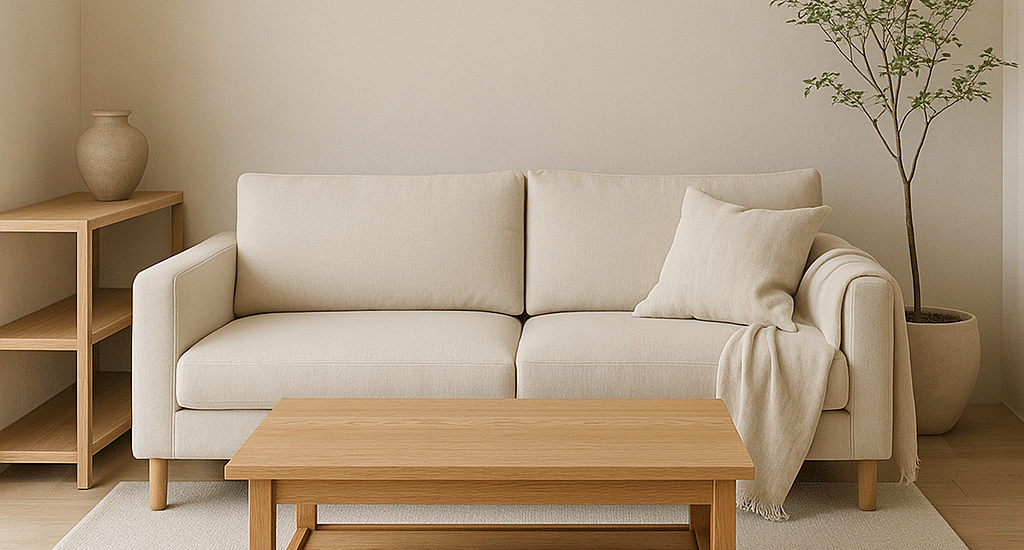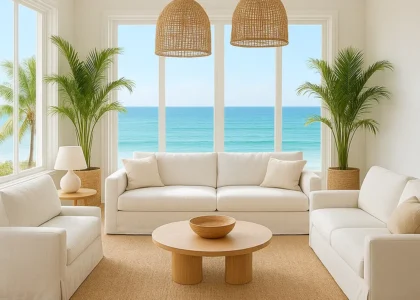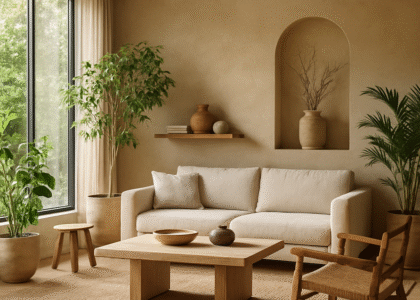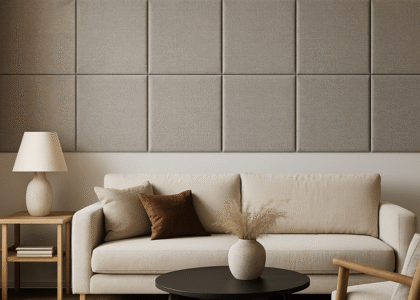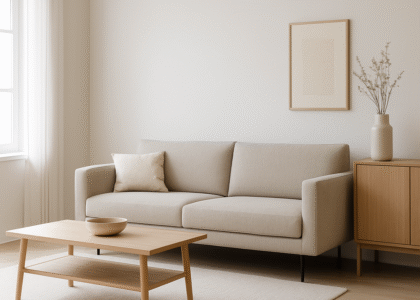Ultimate Guide to Japandi Interior Design
In 2025, homeowners, architects, and interior designers alike continue to embrace the calm, minimalist beauty of Japandi interior design. This style uniquely blends Japanese wabi-sabi elegance with Scandinavian hygge warmth, resulting in spaces that feel balanced, functional, and effortlessly stylish. Loved for its dedication to natural materials, clean lines, and purposeful living, Japandi remains one of the most influential design movements of recent years — making it an ideal choice for anyone looking to refresh their space with japandi interior design.
Beyond its aesthetic appeal, Japandi speaks to a deeper need for harmony in the modern home. In a world that feels increasingly fast-paced and digital, this design invites us to slow down, notice textures, and choose quality over quantity. It’s a lifestyle choice as much as a visual style.
What is Japandi Interior Design?
Japandi interior design combines two distinct philosophies: the Japanese wabi-sabi appreciation for imperfection and transience, and the Scandinavian pursuit of coziness and functionality. Together, they create interiors that feel serene yet warm, minimalist yet personal.
Rooted in a shared love for simplicity, natural elements, and quality craftsmanship, Japandi strikes the perfect balance between aesthetic restraint and soulful warmth. Japanese interiors lean toward refined minimalism, celebrating asymmetry, muted palettes, and organic materials. Scandinavian spaces soften this approach with cozy textiles, lighter woods, and functional design.
This marriage of East and North reflects a broader cultural dialogue. Both traditions value sustainable choices, natural materials, and a respect for craftsmanship — ideals that resonate with modern homeowners seeking mindful design.
The magic of Japandi is in the way these seemingly different approaches complement each other. Where wabi-sabi embraces subtle imperfections, Scandinavian design introduces brightness and practicality. When these worlds merge, the result is a harmonious aesthetic perfect for modern living — a concept often discussed in Japandi vs Scandinavian interior difference.
Below is an infographic comparing Japanese, Scandinavian, and Japandi styles, highlighting their unique features and overlapping design philosophies.
Japandi Interior Design: A Timeless Balance of Simplicity and Warmth
Japandi interior design elegantly fuses Scandinavian functionality with Japanese minimalism. The result? Calm, balanced spaces filled with purpose, organic warmth, and a feeling of timeless sophistication.
This part of the guide explores the core elements that define Japandi, offering insight into color palettes, materials, and the subtle details that bring this design language to life.
While trends come and go, the underlying values of Japandi — sustainability, mindfulness, and quality — keep it timeless. That’s why it continues to influence new collections from major furniture brands and artisan workshops alike.
Core Elements of Japandi Style
Neutral Tones & Color Palettes
Japandi interior color palette neutral tones set the foundation for the entire design. Think soft whites, muted grays, pale taupes, and gentle beiges — hues chosen not just for visual harmony but also to calm the mind and soften architectural lines.
Midway through designing bedrooms, many homeowners and designers explore Japandi bedroom color palette ideas, blending peaceful tones that promote restful sleep. Soft sage green, pale terracotta, or even charcoal gray can appear as accent colors, always in muted, earthy shades.
These subtle palettes are not merely aesthetic. They help create a backdrop where natural materials — like linen, oak, and stone — can stand out, and where seasonal accents can be swapped easily without disrupting the harmony of the space.
Natural Materials & Textures
At the heart of Japandi is the tactile richness of natural materials. The best natural textiles for Japandi style include linen, organic cotton, and wool. These fabrics soften the clean geometry of Scandinavian and Japanese furniture, adding warmth and texture.
Popular Japandi natural materials:
-
Linen
-
Bamboo
-
Oak
Hard materials like stone and clay provide earthy counterpoints, while natural finishes celebrate the raw, imperfect beauty central to wabi-sabi. Together, these textures create an interior that feels balanced: minimal yet deeply comforting.
Texture is a quiet storyteller in Japandi interiors: the slight slub of handwoven linen, the grain of unfinished oak, or the rough edge of a ceramic bowl all speak to authenticity and craft.
Minimalist Wood Accents
Wood is central to Japandi interiors — but it’s never overused. Instead, carefully chosen japandi interior minimalist wood accents provide warmth without overwhelming simplicity. Low tables in natural oak, slim floating shelves, and minimalist wood-framed mirrors subtly draw the eye.
Wood grain is often left visible, stained in light or medium tones to keep rooms airy yet grounded. In larger pieces, straight lines and rounded edges mirror both Japanese craftsmanship and Nordic functionality.
Designers often recommend mixing woods subtly: pairing pale oak with slightly darker ash or bamboo adds depth without clutter. The key is restraint and balance.
Indoor Plants & Green Touches
Japandi interior with indoor plants breathes life into neutral-toned spaces. Plants chosen for their sculptural shapes — like fiddle leaf figs, snake plants, or bonsai — enhance the architectural feel of rooms without adding clutter.
Beyond aesthetics, greenery connects interiors to the natural world, which is deeply rooted in both Scandinavian and Japanese design philosophies.
For extra authenticity, ceramic planters in muted glazes or handwoven baskets further tie the organic theme together. Even a single well-chosen plant can transform a corner.
Sustainability in Japandi
Sustainability isn’t an afterthought in Japandi — it’s an essential value. Spaces often incorporate Japandi interior sustainable materials like reclaimed wood, recycled fabrics, and low-VOC finishes.
These choices reduce environmental impact and enhance authenticity. For readers curious about integrating sustainability into home design, see our separate guide on eco-friendly interiors.
Choosing fewer, better pieces over mass-produced furniture keeps the carbon footprint lower and aligns with Japandi’s slow-living philosophy.
Designing Japandi Spaces Room by Room
Moving beyond philosophy, here’s how to translate Japandi interior design into specific rooms — from living areas to compact apartments.
Every room can benefit from Japandi’s thoughtful balance of form and function. The guiding principle? Choose items that serve both aesthetic and practical purposes, while respecting negative space and natural light.
Japandi Living Room Ideas
How to style Japandi living room on budget? Begin by combining affordable basics with second-hand treasures: a thrifted bamboo armchair, DIY linen cushions, or a low-profile media unit.
Budget-friendly ideas:
-
DIY linen pillow covers
-
Sanded and stained thrifted wood tables
-
Minimalist low-profile sofas
This mix keeps costs manageable while adding character and staying true to Japandi’s philosophy of thoughtful simplicity.
Large-scale art isn’t essential — a single wall-mounted branch or ceramic piece can become a focal point. Consider subtle floor lamps or rice paper lanterns to add gentle, layered lighting without clutter.
Japandi Bedroom Inspirations
In Japandi bedrooms, simplicity equals calm. Midway through planning, many find Japandi bedroom low platform bed inspiration especially helpful. Low beds, close to the floor, create visual openness and a grounded feeling.
Layer beds with organic linen bedding and add subtle touches: a single ceramic lamp, a bamboo bench, or a neutral-toned rug.
Bedside tables might be replaced with wall-mounted shelves to keep floor space clear. Incorporate hidden drawers or under-bed storage to maintain a clutter-free environment.
Japandi Kitchen Styling
Japandi kitchen open shelving tips encourage keeping shelves minimal and functional. Display only handmade ceramics, wooden bowls, or a teapot — items that are both beautiful and useful.
Balance open shelving with closed storage to keep everyday clutter hidden, maintaining the clean, airy feel typical of Japandi kitchens.
Materials matter here too: think raw wood, matte-finish tiles, and iron or brass handles for a handcrafted look. Consider drawer organizers made of bamboo to keep utensils orderly.
Japandi Bathroom Details
Japandi bathroom décor ideas focus on transforming utilitarian spaces into restful retreats. Add wood benches, linen shower curtains, and natural stone trays to introduce organic warmth.
Warm lighting and natural scents — like cedar or hinoki — further enhance the spa-like calm.
Opt for wall-mounted vanities to free up floor space and choose matte black or brushed brass fixtures for subtle contrast.
Small Apartment Japandi Design
Small space Japandi apartment design thrives on multifunctionality. Foldable tables, storage ottomans, and wall-mounted desks help maximize floor area.
Muted colors and minimalist furniture prevent rooms from feeling crowded, while natural materials add character.
Sliding shoji-style screens or lightweight linen curtains can act as dividers without blocking light. This helps small spaces feel larger and flexible.
Japandi Home Office Ideas
Japandi home office setup minimalist means clearing clutter and choosing essentials that blend beauty with practicality. Think a simple wood desk, ergonomic chair, and perhaps a single sculptural lamp.
Plants or a linen pinboard bring soft contrast without breaking the clean lines.
Cable management is key: hide cords inside wooden channels or behind natural fabric panels to preserve visual calm.
Japandi Interior Design: Accessory Styling and Advanced Tips
Beyond big furniture choices, Japandi’s magic often lies in the smallest details: handmade accessories, art, and clever lighting.
In creating a Japandi Interior Design DIY, remember that every accessory should feel carefully selected rather than haphazardly gathered. Each item, whether a tea bowl or a linen throw, should have a distinct purpose or narrative behind it.
Japandi Entryway Styling
Midway through styling, many explore Japandi entryway shelf ideas. Floating bamboo or oak shelves hold only what’s needed: a ceramic bowl for keys, a small framed print, and a single potted plant.
Consider adding a simple bench for removing shoes, keeping the floor clear and reinforcing the minimalist aesthetic.
Shelving & Wall Art
Japandi shelving styling ideas focus on restraint. Rather than filling shelves edge-to-edge, display only items that hold meaning.
Mid-paragraph, adding Japandi interior wall art ideas ensures walls remain calm yet interesting: minimalist prints, nature-themed canvases, or handwoven textiles.
Neutral frames or natural wood hangers complement the soft palette, while negative space around each artwork maintains balance.
Lighting & Ambiance
Midway through planning, consider Japandi interior lighting ideas. Soft paper lanterns, linen-shaded floor lamps, or warm LEDs under shelves create layered light.
The goal: an atmosphere that feels gentle and calming, never harsh.
Daylight is equally important: maximize natural light with sheer linen curtains that filter brightness while adding texture.
DIY Furniture & Projects
Mid-paragraph, adding a DIY Japandi coffee table build is a creative way to personalize living spaces. Simple materials and craftsmanship reflect the wabi sabi philosophy.
In Japandi interior design, accessories should feel curated rather than collected. Each piece, from a tea bowl to a linen throw, should serve a purpose or hold a story. Even small DIY projects — like hand-finishing a stool or dyeing linen pillow covers with natural pigments — deepen the connection to your space.
Advanced Styling Tips
Mixing wabi sabi and Scandinavian: Embrace subtle imperfection. Pair slightly cracked ceramics or a rough linen runner with streamlined Nordic furniture.
This layering creates visual depth, balancing softness with structure — a signature Japandi look.
Remember: asymmetry can add life. A single off-center wall hanging or uneven shelf arrangement brings quiet dynamism to minimalist rooms.
Where to Shop Japandi Furniture & Decor
Where to buy Japandi furniture online? Many retailers now offer curated Japandi collections blending Scandinavian simplicity with Japanese elegance.
Shopping tips: focus on quality, natural materials, and neutral tones.
(Image alt text: “Minimalist oak Japandi sideboard with ceramic decor”)
Comparison table:
| Store | Best For | Highlights | Price Range |
|---|---|---|---|
| Hay | Contemporary minimalism | Scandinavian-Japanese blend, clean wood furniture | $$–$$$ |
| Muji | Affordable essentials | Neutral palettes, natural materials, minimalist lines | $–$$ |
| Ferm Living | Stylish accents | Textured ceramics, organic shapes, soft textiles | $$–$$$ |
| IKEA | Budget-friendly basics | Japandi-friendly silhouettes, simple oak furniture | $ |
| Etsy (Handmade Shops) | Unique artisan finds | Hand-carved wood decor, natural textiles | $–$$$ |
Tip: Always check shipping costs, materials sourcing, and customer reviews to ensure you choose pieces that align with Japandi’s emphasis on quality and sustainability.
Deeper Insights into Japandi Interior Design
Seasonal Japandi Styling Tips
One strength of japandi interior design is its flexibility through the seasons. In spring and summer, add fresh greenery like eucalyptus or olive branches in ceramic vases. Swap heavy wool throws for lighter linen or cotton, and roll up darker rugs to reveal pale wood floors. In autumn and winter, introduce soft wool blankets, textured cushions in muted earth tones, and gentle ambient lighting with lanterns or candles. These small changes keep spaces feeling alive and connected to nature — without disturbing the core neutral palette and clean lines that define Japandi.
Common Japandi Mistakes to Avoid
While Japandi interiors look effortless, some beginners slip into clutter or imbalance. Common mistakes include mixing too many wood tones, choosing decor that feels overly rustic, or over-decorating shelves. The best approach is restraint: limit color to muted earth tones, stick to two or three wood finishes, and select accessories carefully. Remember: negative space is as important as furniture. A Japandi space feels calm not just because of what’s added — but because of what’s deliberately left out.
Why Proportion and Scale Matter
In japandi interior design, proportion and scale transform a room from flat to harmonious. Low-profile furniture — like platform beds and low sofas — keeps sightlines open and supports a tranquil atmosphere. Large pieces should be balanced by negative space, while small objects gain impact when isolated rather than crowded. Consider the height of shelving, the scale of pendant lights, and the placement of rugs to guide the eye naturally. Thoughtful scale helps a Japandi space feel curated, calm, and balanced.
Why Japandi Appeals to Modern Living
Japandi interior design resonates today because it answers modern needs: calm in a noisy world, sustainability over disposability, and flexibility for small spaces. Its focus on natural materials aligns with eco-conscious living, while multifunctional furniture fits urban apartments. Beyond visual style, Japandi invites mindfulness — living with fewer, better things and finding beauty in simplicity. This makes it not just a design choice, but a lifestyle rooted in balance, purpose, and well-being.
Final Thoughts & Styling Recap
Bringing Japandi interior design into your home is more than a trend — it’s an embrace of mindful living, natural materials, and timeless simplicity.
With careful choices — low platform beds, minimalist shelves, warm lighting, and a few sculptural accents — any home can feel serene and balanced.
In the end, japandi interior design shows us that beauty isn’t about adding more, but choosing carefully and living intentionally.
Whether starting small with a new linen throw or transforming an entire room, Japandi proves that quiet beauty can be the most powerful.
Thoughtful decluttering lies at the heart of japandi interior design. By removing excess and curating what truly matters — a handcrafted vase, a linen cushion, or a single bonsai — each space becomes calmer, more personal, and effortlessly timeless, reflecting the mindful simplicity that defines this elegant fusion style.
FAQ: Japandi Interior Design
What is Japandi interior design?
A fusion of Japanese minimalism and Scandinavian warmth, focusing on natural materials, clean lines, and balanced calm.
Is Japandi style expensive to create?
Not always; mix affordable basics, second-hand finds, and artisan touches.
Can I use bold colors in Japandi decor?
Mostly muted tones are preferred, but subtle bold accents can add depth.
How to decorate a Japandi bedroom?
Start with a low platform bed, add linen bedding, a ceramic lamp, and keep decor minimal.
Where to buy Japandi furniture?
Online at Muji, Hay, Ferm Living, IKEA, or handmade shops on Etsy.
Adding seasonal touches — like a darker linen throw in winter or fresh eucalyptus in summer — keeps your Japandi interior fresh while staying true to its minimalist philosophy.


